Short summary: Over 2023–2025 the Tinubu administration and relevant agencies have pushed reforms aimed at improving the ease of doing business, stabilizing macroeconomics, and incentivizing private activity. While “no-capital” entrepreneurship is still limited by practical constraints, a combination of policy changes, digital platforms, financial schemes and business models now make it more realistic for a motivated person with skills, networks and hustle to start a scalable, high-income business with little or no upfront capital.
This article explains the policy context, how “starting a high-income business without capital” can work in practice in Nigeria today, step-by-step strategies, risk and compliance considerations, and a short how-to plan you can follow. I end with a motivational investment article that shows how to convert early earnings into lasting capital.
1. Policy and macroeconomic context (what changed and why it matters)
Since taking office, the Tinubu administration has emphasized macroeconomic reform, fiscal consolidation and private-sector growth as central to economic recovery. Key elements that make entrepreneurship easier today include:
- Regulatory and administrative reforms that reduce friction for business registration and operation.Nigeria has seen a multi-year effort to simplify business registration, licensing and digital filing (a trend that predates 2023 but accelerated with new political focus). The effect: faster registration, clearer rules and fewer middlemen for formalizing a small business. This reduces the time and cash typically required to launch (e.g., paid intermediaries, paperwork costs).
- A stated government emphasis on “ease of doing business” and targeted SME support.The presidency has publicly committed to private-sector friendly reforms and programs aimed at small and medium enterprises (SMEs), including targeted support programs, consumer credit schemes and infrastructure commitments that reduce operating costs for entrepreneurs.
- Macro signals: growth and improving investor confidence (but watch the tradeoffs). Nigeria recorded faster GDP growth in Q2 2025 (4.23% year-on-year) after earlier quarters showing slower expansion which is a sign that reforms and oil output recovery helped real activity pick up. At the same time, inflation remains elevated and policy rates stayed high for much of the reform period, although the central bank moved to ease rates in September 2025 in response to cooling inflation. These macro moves matter for entrepreneurs because they affect demand, borrowing costs, and currency stability.
- Improved payment, fintech, and digital marketplace infrastructure.Nigeria’s dynamic fintech ecosystem continues to lower the cost of payments, invoicing, and cross-border transfers, enabling businesses to collect payments and reach customers with minimal capital investment.
Why these changes matter for “no-capital” startups: lower registration costs and faster setup reduce the cash barrier; digital platforms and agent models replace physical capital; targeted credit or consumer loan schemes can supply working capital; macro stabilization improves predictable demand and makes it easier to plan, price and scale.
2. What “start a high-income business without capital” really means
This phrase is often misunderstood. There are three distinct ways to interpret it:
- Zero upfront monetary investment: you truly invest no cash, but you use existing assets (phone, skills, network). This is possible for many service-based, knowledge-based and intermediary models.
- Very low initial cash (micro-capital): you raise tiny amounts quickly via pre-sales, agency arrangements, or bootstrap revenue; some official credit schemes and microfinance programs can help here.
- No fixed capital requirement but sweat equity and time-investment: you commit time and labor instead of cash; you rely on digital platforms, partnerships and revenue-share agreements.
The practical route for most Nigerians will be a hybrid: low or no cash up front + heavy use of digital platforms + smart partnerships and revenue models that monetize skills, time and networks quickly.
3. Business models that can produce high income with little or no capital
Below are business models that are realistic in Nigeria today, paired with the “why it works now” note:
3.1 Service arbitrage / agency model
- What it is: You sell a service (marketing, web design, bookkeeping, logistics coordination) without performing all the work yourself, you contract freelancers, agencies or micro-vendors and keep the margin.
- Why it fits: No inventory or fixed asset needed; payment platforms and marketplaces help you collect fees; improved formalization reduces friction for contracting.
- How to scale to “high income”: Focus on B2B services with recurring billing (SME bookkeeping, payroll processing, digital marketing retainers).
3.2 Skills-to-product (digital services and info products)
- What it is: Turn a skill into digital products online courses, templates, consulting packages, coaching programs.
- Why it fits: Low platform and distribution costs (social media, marketplaces); demand for skills domestically and regionally.
- Monetization: High margins if you package expertise for corporate clients or high-value niche markets.
3.3 Freelancing and remote work (platform monetization)
- What it is: Use global freelancing platforms or local talent marketplaces to sell services (software dev, design, writing, translation).
- Why it fits: Payment rails and fintech integrations mean you can get paid in foreign currencies or Naira; effective when you convert skills to international rates.
- Scaling: Build a boutique agency around initial freelancing clients.
3.4 Dropshipping + digital storefronts / social commerce
- What it is: Sell physical products via online storefronts, social media shops or marketplaces without holding inventory (supplier ships direct).
- Why it fits: Reduced capital tied up in inventory; social commerce and mobile payments make selling easier.
- Caveat: Margins can be thin unless you find high-value niches or premium pricing.
3.5 Gig economy micro-business (delivery, logistics agent, aggregator)
- What it is: Become an aggregator or sub-agent for logistics, last-mile delivery, e-commerce pickups, or payment collection.
- Why it fits: Low capital to start; increasing e-commerce activity creates abundant opportunities.
- Scale route: Acquire or coordinate fleets, then add higher-margin services (B2B logistics).
3.6 Referral & affiliate income (commission models)
- What it is: Earn from referrals to telecoms, payments, insurance, micro-loan platforms and e-commerce.
- Why it fits: Many fintech and consumer services operate affiliate programs; you need audience and marketing skills rather than capital.
3.7 Creative & media businesses (influencer, content monetization)
- What it is: Build attention and monetize via ads, brand deals, paid communities.
- Why it fits: Low production costs for digital creators; demand for Nigeria-specific content is large.
- Scaling: Move to products and services for your audience (courses, paid newsletters, brand collaborations).
3.8 Agribusiness intermediaries (market linkages)
- What it is: Link farmers to buyers, offer aggregation and logistics without owning farmlands.
- Why it fits: Reduces capex and leverages existing agricultural production; government programs often target ag value chains.
4. Step-by-step tactical playbook (how to start today with zero cash)
Below is a practical step plan you can follow. Each step is designed to reduce cash burn and capture revenue fast.
Phase 0: Mindset & validation (Days 0–7)
- Inventory your assets: phone, internet connection, skills, contacts, time.
- Pick one monetizable skill or niche (e.g., bookkeeping for small shops, social media for restaurants, freelance coding). Choosing a high-value niche makes it possible to charge premium rates quickly.
- Validate demand in 48–72 hours: ask 10 potential customers if they’d pay for your service and how much. If at least 3 say yes, proceed.
Phase 1: Launch (Days 7–21)
- Create a minimum viable offering (MVO): a single service or product you can deliver in one week.
- Use free distribution: WhatsApp, Facebook, Instagram, LinkedIn, local WhatsApp groups, and WhatsApp Business for catalog and orders.
- Set terms & collect prepayments: ask for a 30–50% advance or invoice on delivery via Quickteller, Flutterwave, Paystack, or bank transfer. Prepayment = immediate working capital.
Phase 2: Scale early revenue (Weeks 3–12)
- Turn first customers into testimonials and case studies.
- Automate repeat tasks using free tools: WhatsApp templates, Google Forms, basic invoicing spreadsheets or free accounting packages.
- Outsource to contract workers paid per job, not per month. You retain margin and scale capacity without payroll.
- Negotiate supplier or partner credit: ask for 7–30 day terms once you have a few sales.
Phase 3: Use financial and government tools (Month 3+)
- Apply for microcredit or consumer credit schemes targeted at SMEs (government or private fintech programs). Many programs prioritize businesses with proof of revenue.
- Register your business formally (simple registration reduces risk and enables access to institutional buyers). Use the online portals and take advantage of simplified business facilitation rules.
Phase 4: Convert revenue into capital (Months 6–12)
- Reinvest profits into high ROI items: marketing to acquire customers, a good part-time assistant, software that saves time.
- Build recurring revenue (subscriptions, retainers). This is the fastest route to “high income”.
- Seek strategic partnerships: bigger firms that need your service and will pay reliably.
5. Table: Selected government and market enablers and how to use them
| Enabler | What it does | How entrepreneurs with no capital can use it |
|---|---|---|
| Business Facilitation Act / online registration portals | Reduces time/cost to register formal businesses. | Formalize quickly to access institutional sales and eligibility for SME programs. |
| Consumer Credit / SME support programs | Government and policy initiatives to expand credit and support vulnerable businesses. | Qualify with revenue proofs; use for small working capital needs. |
| Fintech payment rails (local PSPs) | Lowers friction for collecting payments online | Start selling and collecting prepayments from customers immediately. |
| Improved logistics / e-commerce growth | More ways to deliver goods without owning assets | Use dropshipping/3PLs to sell physical products without inventory. |
| Digital marketplaces & freelance platforms | Access to domestic/international clients | Sell skills to higher-paying markets and convert foreign earnings to local investment. |
(All enablers cited in earlier referenced sources and national reporting.)
6. Risk, reality check and the limits of “no capital”
Be realistic, “no capital” does not mean “no risk” or “no work”. Key caveats:
- Time is a form of capital: you must be prepared to invest time and sweat equity.
- Market risk: demand may be lower in some niches; validation is essential.
- Operational risk: payments, delivery and quality control all matter outsourcing introduces counterparty risk.
- Macro risk: inflation and currency moves can squeeze margins (inflation in Nigeria remained elevated in 2025 while policy rates were high before the recent easing).
- Regulatory & compliance risk: some sectors (finance, pharmaceuticals, food) require licenses and are not suitable for “no-capital” entry.
7. Practical examples / mini case studies (how this looks in real life)
Case A: Social media manager for restaurants (start with ₦0)
Phase 0: Inventory — smartphone + design skill + free Canva account.
Phase 1: Approach 5 local restaurants, offer a 2-week social media package for ₦20,000 with a 50% upfront payment. Two say yes → ₦20,000 collected.
Phase 2: Deliver content using freelance photographers paid per gig; keep margin. Scale by onboarding 5 more restaurants using testimonials. Repeat.
Case B: Freelance web developer → boutique agency
Start building websites for small businesses; charge $150–$500 per site with 30% upfront. With 5 clients, you generate capital to hire a junior dev and move to retainer models.
Case C: Aggregator for farm produce
Register as an aggregator (low registration cost), collect orders from buyers (buyers pay up front), coordinate collection from smallholder farmers, take commission. Use mobile money and logistics partners.
8. Quick financial planning cheat-sheet (turn early earnings into growth)
Rule of thumb allocation for every Naira earned in the early months:
- 40% reinvest into the business (marketing, tools, outsourcing)
- 30% pay yourself (sustainable living)
- 20% safety & buffer (emergencies / liquidity)
- 10% savings/investment (start small in diversified assets)
Why: Reinforcing the business early accelerates growth; personal payability keeps you motivated; buffers prevent disaster; savings begin the path to long-term wealth.
9. How to access capital-if-you-need-it (without pledging land or heavy collateral)
- Pre-sales & deposits: the simplest “no-capital” funding sell before you deliver.
- Invoice financing / factoring from fintechs: sell an invoice to a fintech and get 70–90% upfront.
- Microcredit and consumer credit schemes: government/fintech programs sometimes provide small working capital to businesses with records. Apply with your revenue documentation.
- Peer networks & rotating savings (ajo/Esusu): use community finance for small quick capital injections.
- Grants & accelerator programs: many NGOs and private programs offer non-dilutive grants for tech and agri startups, apply selectively.
10. A simple 12-month roadmap you can copy (example: digital marketing agency)
Month 0–1: Validate & sign 2 clients with prepayments.
Month 2–3: Deliver, collect testimonials, refine pricing.
Month 4–6: Outsource delivery, take on 4–6 clients, create a monthly retainer option.
Month 7–9: Reinvest profit into a small sales effort, secure 1–2 medium-size B2B contracts.
Month 10–12: Lock in recurring revenue, apply for microcredit to hire a full-time project manager.
11. Nigeria’s 2025 Economic Snapshot: Growth vs. Inflation
The Nigerian economy showed signs of resilience in 2025, as reflected in the GDP growth figures of 3.13% in the first quarter and 4.23% in the second quarter, according to Reuters. This upward trend indicated that key sectors of the economy were beginning to recover, driven by policy reforms, improved oil output, and renewed investor confidence. However, despite the positive momentum in growth, inflation remained a challenge, standing at 20.1% in August 2025. This high inflation meant that the purchasing power of consumers was still under pressure, and businesses had to contend with elevated input costs.
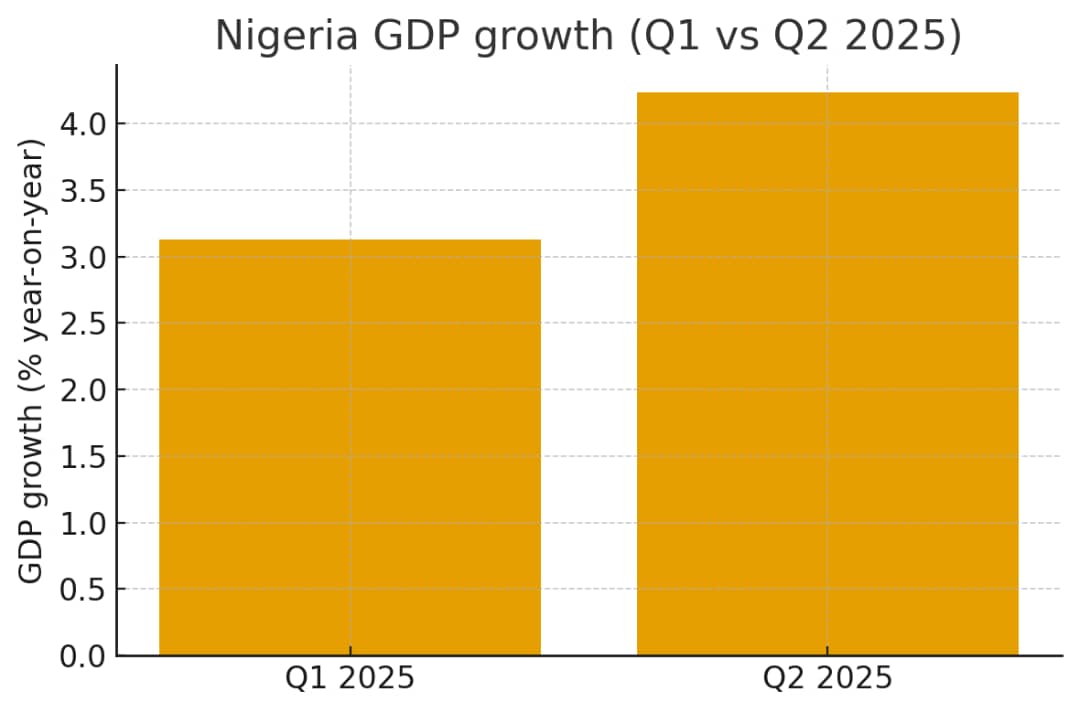
To manage inflationary pressures and maintain economic stability, the Central Bank of Nigeria (CBN) kept monetary policy tight for much of the year, with interest rates set at high levels to curb excessive spending and stabilize the currency. By September 2025, the CBN made a notable policy shift by cutting the Monetary Policy Rate (MPR) to around 27%, signaling a move toward easing.
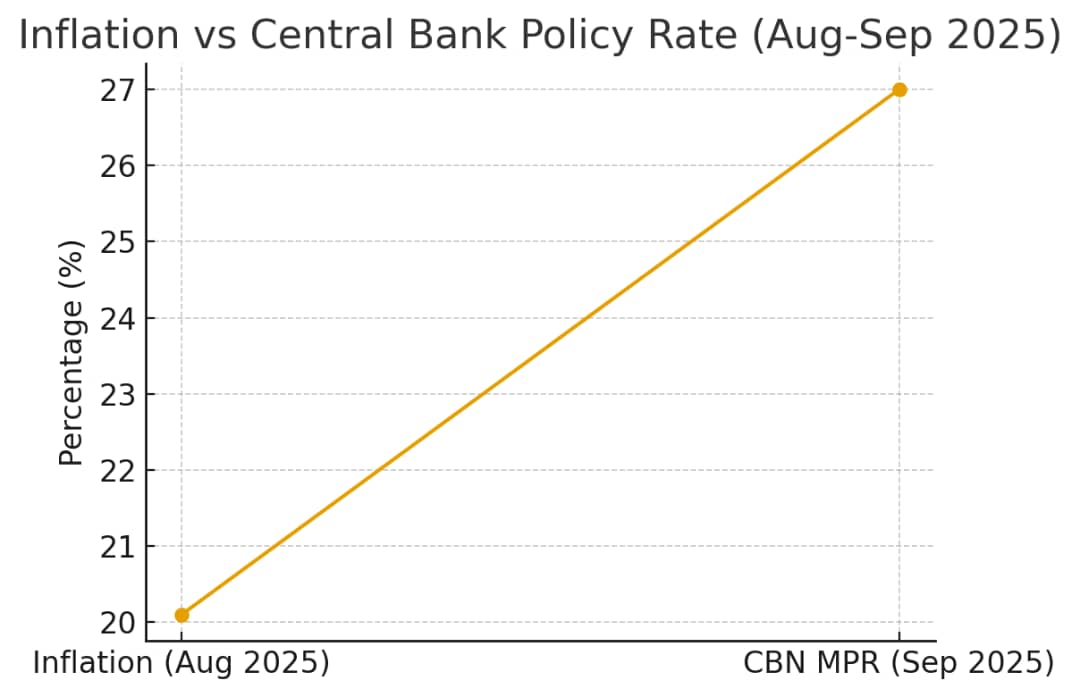
This cut suggested confidence that inflationary pressures were beginning to cool, and it was aimed at encouraging borrowing and investment to sustain growth. Together, these indicators illustrate a macroeconomic environment in transition: one where growth was gaining ground, inflation was still high, but cautious policy adjustments were being introduced to stimulate broader economic activity.


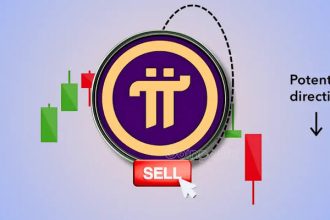

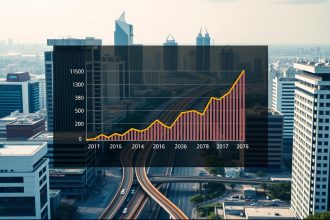







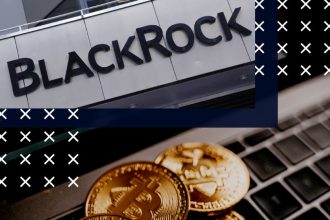
https://t.me/battle_games_com_bot/start?startapp=frndId1891914791
🔥 Hey! Have you missed NOT or Hamster Kombat yet? Then don’t miss BATTLE BULLS – a free PLAY-2-EARN mobile game!
⚡️ In this game, you can earn in-game euros and convert them into REAL tokens after the September AIRDROP!